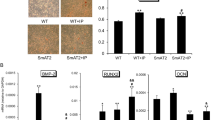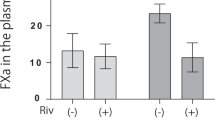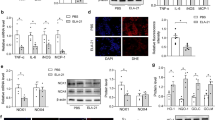Abstract
The blockade of renin–angiotensin II system has been shown to reduce morbidity and mortality in hypertension, atherosclerosis, diabetes and chronic kidney disease. Since vascular calcification (VC) is commonly found in these diseases, the aim of this study was to examine whether or not losartan, a widely used angiotensin II receptor blockers, inhibits VC in rats in vivo. A rat model of VC was generated by treating rats with a combination of warfarin and vitamin K1. Two weeks after the treatments, the rats were treated with vehicle or without losartan (100 ng/kg/day) for 2 weeks. At the end of the experiments, aortic arteries were isolated for the examination of calcification morphology, mRNA and protein expression of BMP2 and Runx2, and osteoblast differentiation. Warfarin and vitamin K instigated vascular remodeling with calcified plaques in the aortic arteries in rats. Losartan significantly attenuated warfarin- and vitamin K-induced vascular injury and calcification. Consistently, losartan suppressed the levels of mRNA and protein expression of BMP2 and Runx2, two key factors for VC. Further, vascular calcified lesion areas expressed angiotensin II 1 receptor (AT1R). Finally, losartan treatment significantly inhibited apoptosis in vascular smooth muscle cell (VSMC) in rat arteries. We conclude that losartan suppresses VC by lowering the expression of AT1R, Runx2 and BMP2, and by inhibiting the apoptosis of VSMC in rat aortic arteries.






Similar content being viewed by others
References
Fischer, J. W., Steitz, S. A., Johnson, P. Y., Burke, A., Kolodgie, F., Virmani, R., et al. (2004). Decorin promotes aortic smooth muscle cell calcification and colocalizes to calcified regions in human atherosclerotic lesions. Arteriosclerosis, Thrombosis, and Vascular Biology, 24, 2391–2396.
Li, X., Yang, H. Y., & Giachelli, C. M. (2008). BMP-2 promotes phosphate uptake, phenotypic modulation, and calcification of human vascular smooth muscle cells. Atherosclerosis, 199, 271–277.
Zamurovic, N., Cappellen, D., Rohner, D., & Susa, M. (2004). Coordinated activation of notch, Wnt, and transforming growth factor-beta signaling pathways in bone morphogenic protein 2-induced osteogenesis. Notch target gene Hey1 inhibits mineralization and Runx2 transcriptional activity. Journal of Biological Chemistry, 279, 37704–37715.
Speer, M. Y., Li, X., Hiremath, P. G., & Giachelli, C. M. (2010). Runx2/Cbfa1, but not loss of myocardin, is required for smooth muscle cell lineage reprogramming toward osteochondrogenesis. Journal of Cellular Biochemistry, 110, 935–947.
Volpe, M., Cosentino, F., Tocci, G., Palano, F., & Paneni, F. (2011). Antihypertensive therapy in diabetes: the legacy effect and RAAS blockade. Current Hypertension Reports, 13, 318–324.
Han, H. (2013). Blood pressure medications: ACE-I/ARB and chronic kidney disease. Journal of Renal Nutrition, 23, e105–e107.
Hermida, R. C., Ayala, D. E., Fernandez, J. R., Portaluppi, F., Fabbian, F., & Smolensky, M. H. (2011). Circadian rhythms in blood pressure regulation and optimization of hypertension treatment with ACE inhibitor and ARB medications. American Journal of Hypertension, 24, 383–391.
Maahs, D. M., Snell-Bergeon, J. K., Kinney, G. L., Wadwa, R. P., Garg, S., Ogden, L. G., et al. (2007). ACE-I/ARB treatment in type 1 diabetes patients with albuminuria is associated with lower odds of progression of coronary artery calcification. Journal of Diabetes and Its Complications, 21, 273–279.
Armstrong, Z. B., Boughner, D. R., Drangova, M., & Rogers, K. A. (2011). Angiotensin II type 1 receptor blocker inhibits arterial calcification in a pre-clinical model. Cardiovascular Research, 90, 165–170.
Kruger, T., Oelenberg, S., Kaesler, N., Schurgers, L. J., van de Sandt, A. M., Boor, P., et al. (2013). Warfarin induces cardiovascular damage in mice. Arteriosclerosis, Thrombosis, and Vascular Biology, 33, 2618–2624.
Villines, T. C., O’Malley, P. G., Feuerstein, I. M., Thomas, S., & Taylor, A. J. (2009). Does prolonged warfarin exposure potentiate coronary calcification in humans? Results of the warfarin and coronary calcification study. Calcified Tissue International, 85, 494–500.
Schurgers, L. J., Spronk, H. M., Soute, B. A., Schiffers, P. M., DeMey, J. G., & Vermeer, C. (2007). Regression of warfarin-induced medial elastocalcinosis by high intake of vitamin K in rats. Blood, 109, 2823–2831.
McCabe, K. M., Booth, S. L., Fu, X., Shobeiri, N., Pang, J. J., Adams, M. A., et al. (2013). Dietary vitamin K and therapeutic warfarin alter the susceptibility to vascular calcification in experimental chronic kidney disease. Kidney International, 83, 835–844.
Price, P. A., Faus, S. A., & Williamson, M. K. (1998). Warfarin causes rapid calcification of the elastic lamellae in rat arteries and heart valves. Arteriosclerosis, Thrombosis, and Vascular Biology, 18, 1400–1407.
Yao, Y., Bennett, B. J., Wang, X., Rosenfeld, M. E., Giachelli, C., Lusis, A. J., et al. (2010). Inhibition of bone morphogenetic proteins protects against atherosclerosis and vascular calcification. Circulation Research, 107, 485–494.
Becker, R. C. (2007). Warfarin-induced vasculopathy. Journal of Thrombosis and Thrombolysis, 23, 79–81.
Utsunomiya, H., Yamamoto, H., Kunita, E., Kitagawa, T., Ohashi, N., Oka, T., et al. (2010). Combined presence of aortic valve calcification and mitral annular calcification as a marker of the extent and vulnerable characteristics of coronary artery plaque assessed by 64-multidetector computed tomography. Atherosclerosis, 213, 166–172.
Shalhoub, V., Shatzen, E. M., Ward, S. C., Young, J. I., Boedigheimer, M., Twehues, L., et al. (2010). Chondro/osteoblastic and cardiovascular gene modulation in human artery smooth muscle cells that calcify in the presence of phosphate and calcitriol or paricalcitol. Journal of Cellular Biochemistry, 111, 911–921.
Theuwissen, E., Smit, E., & Vermeer, C. (2012). The role of vitamin K in soft-tissue calcification. Advances in Nutrition, 3, 166–173.
Derwall, M., Malhotra, R., Lai, C. S., Beppu, Y., Aikawa, E., Seehra, J. S., et al. (2012). Inhibition of bone morphogenetic protein signaling reduces vascular calcification and atherosclerosis. Arteriosclerosis, Thrombosis, and Vascular Biology, 32, 613–622.
Shimizu, T., Tanaka, T., Iso, T., Matsui, H., Ooyama, Y., Kawai-Kowase, K., et al. (2011). Notch signaling pathway enhances bone morphogenetic protein 2 (BMP2) responsiveness of Msx2 gene to induce osteogenic differentiation and mineralization of vascular smooth muscle cells. Journal of Biological Chemistry, 286, 19138–19148.
Aziz, A., Miyake, T., Engleka, K. A., Epstein, J. A., & McDermott, J. C. (2009). Menin expression modulates mesenchymal cell commitment to the myogenic and osteogenic lineages. Developmental Biology, 332, 116–130.
Tsuji, K., Komori, T., & Noda, M. (2004). Aged mice require full transcription factor, Runx2/Cbfa1, gene dosage for cancellous bone regeneration after bone marrow ablation. Journal of Bone and Mineral Research, 19, 1481–1489.
Chen, W., Ma, J., Zhu, G., Jules, J., Wu, M., McConnell, M., et al. (2014). Cbfbeta deletion in mice recapitulates cleidocranial dysplasia and reveals multiple functions of Cbfbeta required for skeletal development. Proceedings of the National Academy of Sciences of the United States of America, 111, 8482–8487.
Chen, H., Ghori-Javed, F. Y., Rashid, H., Serra, R., Gutierrez, S. E., & Javed, A. (2011). Chondrocyte-specific regulatory activity of Runx2 is essential for survival and skeletal development. Cells Tissues Organs, 194, 161–165.
Byon, C. H., Sun, Y., Chen, J., Yuan, K., Mao, X., Heath, J. M., et al. (2011). Runx2-upregulated receptor activator of nuclear factor kappaB ligand in calcifying smooth muscle cells promotes migration and osteoclastic differentiation of macrophages. Arteriosclerosis, Thrombosis, and Vascular Biology, 31, 1387–1396.
Sun, Y., Byon, C. H., Yuan, K., Chen, J., Mao, X., Heath, J. M., et al. (2012). Smooth muscle cell-specific runx2 deficiency inhibits vascular calcification. Circulation Research, 111, 543–552.
Osako, M. K., Nakagami, H., Shimamura, M., Koriyama, H., Nakagami, F., Shimizu, H., et al. (2013). Cross-talk of receptor activator of nuclear factor-kappaB ligand signaling with renin–angiotensin system in vascular calcification. Arteriosclerosis, Thrombosis, and Vascular Biology, 33, 1287–1296.
Jia, G., Stormont, R. M., Gangahar, D. M., & Agrawal, D. K. (2012). Role of matrix Gla protein in angiotensin II-induced exacerbation of vascular calcification. American Journal of Physiology Heart and Circulatory Physiology, 303, H523–H532.
Yoon, H. E., Ghee, J. Y., Piao, S., Song, J. H., Han, D. H., Kim, S., et al. (2011). Angiotensin II blockade upregulates the expression of Klotho, the anti-ageing gene, in an experimental model of chronic cyclosporine nephropathy. Nephrology, Dialysis, Transplantation, 26, 800–813.
Chai, W., Wang, W., Liu, J., Barrett, E. J., Carey, R. M., Cao, W., et al. (2010). Angiotensin II type 1 and type 2 receptors regulate basal skeletal muscle microvascular volume and glucose use. Hypertension, 55, 523–530.
Sui, Y. B., Chang, J. R., Chen, W. J., Zhao, L., Zhang, B. H., Yu, Y. R., et al. (2013). Angiotensin-(1-7) inhibits vascular calcification in rats. Peptides, 42, 25–34.
Kapustin, A. N., Davies, J. D., Reynolds, J. L., McNair, R., Jones, G. T., Sidibe, A., et al. (2011). Calcium regulates key components of vascular smooth muscle cell-derived matrix vesicles to enhance mineralization. Circulation Research, 109, e1–e12.
Shroff, R. C., McNair, R., Figg, N., Skepper, J. N., Schurgers, L., Gupta, A., et al. (2008). Dialysis accelerates medial vascular calcification in part by triggering smooth muscle cell apoptosis. Circulation, 118, 1748–1757.
Gui, T., Zhou, G., Sun, Y., Shimokado, A., Itoh, S., Oikawa, K., et al. (2012). MicroRNAs that target Ca(2+) transporters are involved in vascular smooth muscle cell calcification. Laboratory Investigation, 92, 1250–1259.
Byon, C. H., Javed, A., Dai, Q., Kappes, J. C., Clemens, T. L., Darley-Usmar, V. M., et al. (2008). Oxidative stress induces vascular calcification through modulation of the osteogenic transcription factor Runx2 by AKT signaling. Journal of Biological Chemistry, 283, 15319–15327.
Koleganova, N., Piecha, G., Ritz, E., Schirmacher, P., Muller, A., Meyer, H. P., et al. (2009). Arterial calcification in patients with chronic kidney disease. Nephrology, Dialysis, Transplantation, 24, 2488–2496.
Ripley, D. P., Negrou, K., Oliver, J. J., Worthy, G., Struthers, A. D., Plein, S., et al. (2014). Aortic remodelling following the treatment and regression of hypertensive left ventricular hypertrophy: A cardiovascular magnetic resonance study. Clinical and Experimental Hypertension. doi:10.3109/10641963.2014.960974.
Acknowledgments
This work was supported by the grant from the National Natural Science Foundation of China (No. 81270355) and the grants from the Fund of the Science and Technology Department of Hubei Province, China (2014CFB211). We thank Dr. Ming-Hui Zou for his critical review of the manuscript.
Conflict of interest
The authors have declared that no competing interests exist.
Author information
Authors and Affiliations
Corresponding authors
Rights and permissions
About this article
Cite this article
Li, M., Wu, P., Shao, J. et al. Losartan Inhibits Vascular Calcification by Suppressing the BMP2 and Runx2 Expression in Rats In Vivo. Cardiovasc Toxicol 16, 172–181 (2016). https://doi.org/10.1007/s12012-015-9326-y
Published:
Issue Date:
DOI: https://doi.org/10.1007/s12012-015-9326-y




